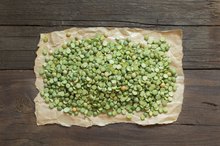Green Pepper Nutrition Information
According to the Agricultural Marketing Resource Center, the consumption of bell peppers increased from an average of eight pounds per person in 2000 to 10 pounds in 2008. The increase signals a positive trend toward healthy eating, as green bell peppers are a great source of nutrients.
Definition
Green peppers, along with the yellow, orange and red varieties, are members of the bell pepper family. Even though the culinary world considers them to be vegetables, bell peppers are actually fruits from the species Capsicum annuum.
Basic Nutrition
Green Chile Nutrition
Learn More
According to the USDA, one medium-sized green pepper has 24 calories, 2 grams (g) of dietary fiber and 3 grams of sugar. It also contains 1 milligram of protein. Even though green peppers have all the amino acids, they are not all present in sufficient quantity and proportion to qualify as a complete protein.
Vitamins
Green peppers are a good source of vitamin K and vitamin B6, with 10 strips providing about 3 percent of the daily value of each one. Ten strips also provide about 2.25 percent of the daily value of vitamin A. Other vitamins present in small amounts include:
- vitamin E
- thiamin
- riboflavin
- niacin
- folate
- pantothenic acid
Minerals
Hog Plum Health Benefits
Learn More
While green peppers contain a variety of minerals, they’re only present in trace amounts. The two most abundant minerals are potassium and manganese. Ten strips of green pepper will provide about 1.5 percent of the DV for potassium and 1.75 percent for manganese.
Other Nutrients
You might be surprised to learn that green peppers also contain the healthy omega-3 and omega-6 fatty acids. One medium green pepper has 64.3 milligrams of omega-6 fatty acids and 9.5 milligrams of omega-3 fatty acids. Orange and red bell peppers have significantly higher amounts of lutein and zeaxanthin, but a medium-sized green pepper provides 0.41 milligrams of these important antioxidants. You’ll also benefit from 10.7 milligrams of phytosterols, which help to lower the “bad” LDL cholesterol.
- You might be surprised to learn that green peppers also contain the healthy omega-3 and omega-6 fatty acids.
- Orange and red bell peppers have significantly higher amounts of lutein and zeaxanthin, but a medium-sized green pepper provides 0.41 milligrams of these important antioxidants.
Considerations
When researching nutrition information, be sure to pay attention to the portion size. The size of the medium green pepper tested by the USDA was 119 grams and their medium orange was 141 grams. The two weights are the closest match to be found in the available data. By comparison, 10 strips of green pepper represent 27 grams. It’s still fair to say that green peppers are a great source of vitamin C, but a more typical serving size will not give you nearly the daily value that the nutrient chart might indicate for a different portion.
- When researching nutrition information, be sure to pay attention to the portion size.
- It’s still fair to say that green peppers are a great source of vitamin C, but a more typical serving size will not give you nearly the daily value that the nutrient chart might indicate for a different portion.
Related Articles
References
- Peppers, sweet, red, raw. FoodData Central. U.S. Department of Agriculture. Published April 1, 2019.
- Pepper, sweet, green, raw. U.S. Department of Agriculture. Published April 1, 2020.
- National Institutes of Health Office of Dietary Supplements. Vitamin C fact sheet for health professionals. Updated July 9, 2019.
- National Institutes of Health Office of Dietary Supplements. Manganese fact sheet for health professionals. Updated September 6, 2019.
- Fiedor J, Burda K. Potential role of carotenoids as antioxidants in human health and disease. Nutrients. 2014;6(2):466-88. doi:10.3390/nu6020466
- Mozos I, Stoian D, Caraba A, Malainer C, Horbańczuk JO, Atanasov AG. Lycopene and Vascular Health. Front Pharmacol. 2018;9:521. doi:10.3389/fphar.2018.00521
- Shotorbani N, Jamei R, Heidari R. Antioxidant activities of two sweet pepper Capsicum annuum L. varieties phenolic extracts and the effects of thermal treatment. Avicenna J Phytomed. 2013;3(1):25-34.
- Centers for Disease Control and Prevention. Learn about age-related macular degeneration. Updated July 18, 2018.
- Eisenhauer B, Natoli S, Liew G, Flood VM. Lutein and zeaxanthin--food sources, bioavailability and dietary variety in age-related macular degeneration protection. Nutrients. 2017;9(2). doi:10.3390/nu9020120
- Boyd K. Vitamins for AMD. American Academy of Ophthalmology. Updated May 21, 2018.
- Maioli C, Tagliabue L, Cioni F. Osteoporosis and mineral nutrition. A literature review. Progr Nutr. 2018;20(3):305-12. doi:10.23751/pn.v20i3.6861
- Nucera E, Rizzi A, Buonomo A, et al. The clinical meaning of positive latex sIgE in patients with food/pollen adverse reactions. Int J Immunopathol Pharmacol. 2012;25(2):445-53. doi:10.1177/039463201202500214
- Aghajanpour M, Nazer MR, Obeidavi Z, Akbari M, Ezati P, Kor NM. Functional foods and their role in cancer prevention and health promotion: a comprehensive review. Am J Cancer Res. 2017;7(4):740-769.
Resources
Writer Bio
Sandi Busch received a Bachelor of Arts in psychology, then pursued training in nursing and nutrition. She taught families to plan and prepare special diets, worked as a therapeutic support specialist, and now writes about her favorite topics – nutrition, food, families and parenting – for hospitals and trade magazines.









